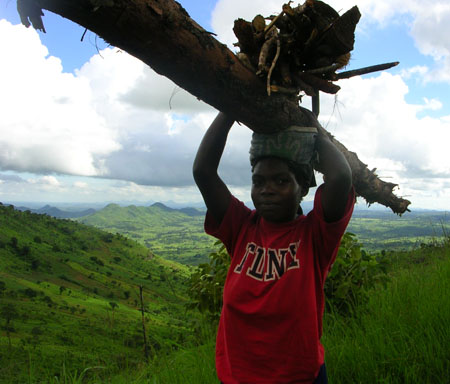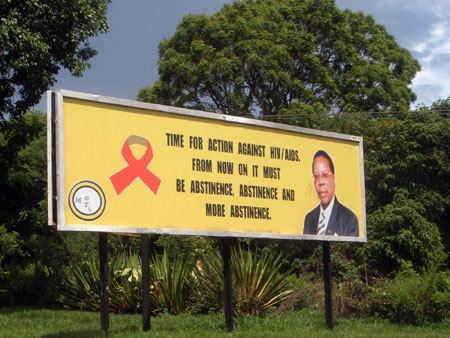Jesse Rankin
I am now finding it difficult to use the word sustainable because it’s bandied about so often that it is becoming a cliche. It is still much better than “providing solutions” from my perspective but a minor point either way. It does beget the question; what is sustainable graphic design? More specifically, what is sustainable graphic design in Malawi? At the very least a low priority when you’re talking about a society that struggles to feed itself. Perhaps a sustainable design project is one that would continually communicate how detrimental it is to rely on one crop which is what is done here in Malawi (Maize). But I’m getting ahead of myself. I believe some background information is prudent.
First of all, I came here as a house husband following my wife Jennifer who is a nurse practitioner focusing on HIV/AIDS. Fortunately I was able to find freelance work as a designer/developer working mostly on web sites. An interesting aspect of this is that NGOs and non-profits have bigger budgets for web sites than do local business people. Development is big business in Africa and when you start to hear some of the stories of ineptitude it can be quite frustrating. This does not mean there are not success stories but living in Malawi puts you in a place of great contradictions. A place where it is hard for me to think about spreading the gospel of graphic design when people really just need running water for starters. But maybe that is just me getting overwhelmed by what I’m seeing and experiencing and not looking for answers (notice I didn’t say solutions).

Firewood
The question is how can graphic design actually help Malawi in the development process to becoming a self sustaining country? Graphic design’s role is that of assisting in communicating larger initiatives as well as smaller ones. In Malawi one of the best ways to bring this to fruition would be to convince Malawians that they need to diversify their crops. Since the autocratic administration of Dr. Hastings Banda (Prime Minister and Head of Gov’t 1964 – 1966; President 1966 – 1994) Malawians have relied on Maize as their main food source which they process (thereby removing most nutrients) into Nsima (IN-Seema). It is culturally ingrained that Nsima is the best food and the society is very attached to it and so far does not seem able to incorporate enough variety into its regular diet. There are continuing attempts to encourage Malawians to expand their dietary variety including making the campaign part of a local soap opera.
But how many of the 14 or 16 million Malawians have access to a television? It would take a multi-faceted campaign involving mostly print media that was promoted across the entire country and then it would have a chance of working. It would also have to be in Chichewa (local language) as well as English. Most importantly, the campaign would have to be written, run and supported by Malawians most likely with some western assistance. If not run by Malawians then why bother? The campaign could still be effective if completed by a western NGO but this approach would perpetuate the dependency culture that is the reality here. Is this entirely the fault of NGOs and westerners? No, but if new strategies are not developed Malawi could be no better off in 30 years time than it is today.

Abstinence
I worry sometimes that I come across as a cynic and that is just not the case. Chishango condoms have been very successful in Malawi partly due to their marketing campaign. I had heard initially that their shield imagery (Chishango is Chichewa for shield) did not go over well with locals but I could not verify this fact. I do know that they changed their campaign in 2002 and have helped spur dialogue regarding safe sexual practices as well as providing 95% of the condoms in Malawi. Perhaps the reason for the pessimistic tone is that I see and hear about many failures due to lack of communication amongst NGOs, governmental corruption, and sometimes just because the wrong person has been brought in to do a particular job. So how do I try and make a difference? By recognizing (hopefully) what I can and cannot do especially given the finite amount of time I will end up living in Malawi. As I went forth finding work with organizations I partnered with another American ex-pat. We were building a site for an environmental organization and were using the open source blogging software WordPress. We knew they would need someone to manage the site so we started to think of Malawians we knew that could do the job. We thought of a couple and found one to handle the management of the site and to learn WordPress. Mind you, this man is a talented programmer who can handle more complex tasks then site management but gaining entrance to the ex-pat business community is probably the most valuable aspect of the project for this particular Malawian. He already has a good job but there are few companies and individuals in Lilongwe that are capable of offering the type of services many of the NGOs and foreign governments need. It potentially creates a new entrepreneur who can then train locals so work is not potentially taken by American house husbands. I have also tried to mentor a friend’s gardener to help him with web design as well as giving him a book to learn PHP and MySQL. What are the chances of success? I’d say 50% based on what I’ve seen from these two individuals, none of which has much to do with me. But the effort is still worth it and a little hand up can go a long way.

Condoms
The project I am working on now is for Lighthouse. Lighthouse is an HIV/AIDS clinic in Lilongwe that was started by Clinical Officers and Nurses who volunteered their time while working at the main hospital in town called Kamuzu Central Hospital. This is where my wife Jennifer works and is how the work came my way. Lighthouse has an I.T. person but he is swamped so I was brought in to assist and mentor him a bit regarding web design and to design a poster. For me this is a dream project because I believe in what this organization is doing and the web site and poster will help communicate their mission to more people. For the website we are modifying WordPress so that the site is easy to update by not only their I.T. person but other staff as well so the site is a living, breathing document, not just a timestamp. Perhaps this is my idea of sustainable graphic design in Malawi: to work yourself out of a job by showing others how to do it. Not only does it sustain itself once in the clients and locals hands, but it also sustains my own motivation to continue to search out projects such as this until there’s no more room for me.
 Lighthouse
Lighthouse
Jesse Rankin earned a certificate in Graphic Design from New York University in 2003 after years of working in I.T. He is currently living in Malawi, East Africa doing freelance web design and development. He also has a blog loungechicken where he writes about Malawi and the absurdities of this world as well as a site (http://www.yessa.org – under development) to display other works such as photography.











May 4, 2006 at 3:37 pm
jesse-i REALLY enjoyed reading your article. i share your perspective on design sustainabily and was very encouraged by your example and what you wrote! thanks, jenny